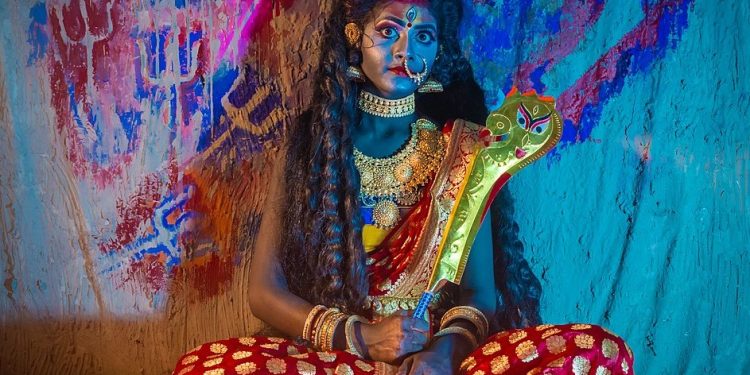In my understanding of Hinduism, there is more in its nature of study and deliberations than just religion.
In this context, the chapter of Goddess Kali divulges an aspect of Hindu thought and philosophy apart from rationality, spirituality, morality, and myths.
Goddess Kali is an exciting and intriguing reading. In addition to her ritualistic adoration and worshipping, the study reveals her unique temperament that adds to the diverse outlook of Hinduism.
Kali’s appearance is dark blue with sunken eyes. Kali typically portrays herself with a scary and angry stare in her lengthy, blood-red tongue sticking out in a ferocious image.
Her scantly covered body has a long garland of severed skulls of demons whom she destroyed after listening to the requests of her followers. And her short skirt is the ripped-out arms of the defeated enemies.
Kali often appears in the blood-thirsty and feral image. There is blood dripping from the chopped heads of demons that she holds in her arms. Her mood is terrifying and unruly. Indeed, seeing other Hindu goddesses wrapped in colourful sarees and wearing beautiful jewelry, Kali is not a pleasant sight. Moreover, she is not the kind of deity often displayed in most Hindu in-home shrines or her picture on hanging calendars.
Kali’s overall personality is revealed in an astounding story when she defeats a powerful demon named Raktabija. Other female deities fought against him. They were able to wound him. But the story goes like this: every drop from each wound inflicted on him would become a clone of the demon Raktabija. Thus, fighting against him by the deities meant increasing the army of his duplicates.
The deities finally gave up. They requested Kali to finish the demon because only she had the divine Shakti, meaning power, to kill him.
With a gaping mouth, her tongue lolling out, and deep reddish eyes filling the regions of the sky with her roars, Kali singlehandedly fought the battle with the demon and the army of his replicas. Kali eventually defeated him by sucking his blood before it could reach the ground. Raktabija, along with his army of duplicates, were all finished. Her winning trophies were the several heads of the devil around her neck.
In euphoria, she went into a wild dance. The more she danced, the wilder and turbulent it became. She was rampaging out of control. Her dancing swirls became so powerful that there was a fear Kali could destroy the world.
In that situation, Lord Shiva was sent to calm Kali down. He was successful but got stomped under her left foot. The forceful, wild dance came to a halt. And the world was saved by Lord Shiva, who is himself attributed as the lord of destruction.
Kali is often portrayed standing or dancing on Lord Shiva, who lies calm and prostrate beneath her foot. Acclaimed mythological artist Raja Ravi Varma captures the dance scene in one of his most famous paintings. Here, Lord Shiva, one of the Trinity Hindu gods, the others Brahma and Vishnu, is seen under her foot.
Kali’s unusual portrayal in her body wears wild and vicious looks and a vigorous victory dance. At the same time, Lord Shiva, a God himself, under her foot, is the material for an interpretive view of her to establish what she represents.
Quintessential embodiment of Shakti
Kali is a Hindu goddess of death, time, and destruction. She is the quintessential embodiment of Shakti, representing the divine feminine power. Kali is like a mad storm, typhoon, or wildfire who does not spare anybody in her furious crusade.
She is a force of nature where her actions or motives are mystified as they defy reasons and explanations. Like nature, she has a destructive trait representing its rough and uncontrolled behaviour, besides delivering generous goodwill. All that results in her being powerful.
Kali is independent and not worried about the results of her actions. Her moves are disciplined. She is a demon slayer, and her psyche represents justifiable female resentment and rage.
Although she is paired with Parvati, Lord Shiva’s wife, she represents a dark, wild, and angry personality here as Kali. Her other image as being Parvati or goddess Gauri is that of calm and tranquil temperament.
A womanhood in multiple traits
In this duality, and with her four, eight, or ten arms that carry a mix of belligerent and luminous symbolisms, Kali represents womanhood in multiple portraits. The many roles contemporary woman juggles, the challenges, and the fights or battles she undertakes are what goddess Kali means.
Kali represents a feminist icon in contemporary society who is not bound by societal norms and restrictions. She is a goddess with motherly love without being labelled to the customary appearance of a mother.
She is a symbol of contemporary womanhood, especially in the West. Kali was on the cover page of the first edition of Ms. Magazine. Its artist, Miriam Wosk, drew a colourful illustration featuring a pregnant woman with eight arms, symbolizing the multi-tasking role of women now and for generations. Rolling Stones, the English rock band, had its logo of “tongue and lip design” adopted out of the stuck-out tongue of Kali.
Despite her portrayed terrible look, Kali is considered the kindest and loving goddess. Ma-Kali, mother Kali, is her revered status in the iconology of Hindu gods. She is the mother of the entire universe and a divine protector.
Kali is a free goddess ready to fight evil in any Yuga.











